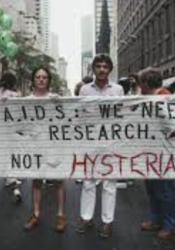AIDS Epidemic & Its Presence Throughout the United States
First beginning in the 1980s, the AIDS epidemic was marked as one of the most well-known public health epidemics within the contemporary United States. As such an epidemic can be described, placed, and analyzed within a timeline format, still today the issue of AIDS and sexually transmitted disease brings devastation to our country. Further marked with heavy assumption and accusation, the AIDS epidemic was often characterized by a great stigma surrounding the issues and topics of sexuality– specifically within the homosexual community. During this time, the AIDS epidemic was described as a global hardship and obstacle regarding the health, prosperity, and well being of United States’ citizens.
During its time, the AIDS epidemic was a national, even global, issue. June 5, 1981 marked the first date of which AIDS appeared within the United States as a sexually transmitted disease, one that can be spread to others. Immediately, this epidemic became face-to-face with much questioning and concern surrounding the exact way in which such a disease could be transmitted from human to human. As noted by author Paula Treichler, in a 1987 journal article on the topic of AIDS, various misconceptions existed regarding the topic of AIDS and its transmission. “The biggest misconception that we have encountered and that most cities…have seen is that many people feel that casual contact– being in the same room with an AIDS victim– will transmit the virus and may infect them,” Treichler states. It can be said that this outbreak and epidemic spanned all across the globe, serving to elicit questions, stereotypes, and discrimination to those who possessed the disease.
Upon its discovery, the infection of HIV and AIDS was met with great debate and discrimination, specifically within the homosexual community. Often labeled as the “gay man’s pneumonia,” AIDS, and the possession of the disease, was quickly met with acts of discrimination and questioning regarding one’s sexuality and the sexual lives of gay men. Furthermore, the issues that exist in relation to the topic of such a disease as this are often linked to challenges surrounding representation and approval of homosexual men during this time. In a way, this epidemic served as ammunition to further oppress and discriminate against those often labeled as “other”. Cheryl Ware states that, “The HIV and AIDS epidemic decimated gay male populations around the world,” further supporting the conversation regarding the topics of oppression and discrimination.
Still just recently and today, the issue of representation and treatment of homosexual men and women throughout the United States is a grave issue. Still today, members of the LGBTQIA+ community often face difficulties and hardships regarding their lifestyle and sexuality in terms of equality impartiality. With many suggestions given regarding how to combat this global epidemic, it is said that, “a comprehensive AIDS plan be developed and that universal health care be provided for all Americans,” in a 1991 column written in the Indianapolis Star.
Works Cited
"September 26, 1991 (Page 4 of 48)." Indianapolis Star (1923-2004), Sep 26, 1991, pp. 4. ProQuest, http://ulib.iupui.edu/cgi-bin/proxy.pl?url=http://search.proquest.com/hi....
Treichler, Paula A. “AIDS, Homophobia, and Biomedical Discourse: An Epidemic of Signification.” October, vol. 43, 1987, pp. 31–70, https://doi.org/10.2307/3397564. Accessed 1 May 2022.
Ware, Cheryl. “‘Things You Can’t Talk about’: Engaging with HIV-Positive Gay Men’s Survivor Narratives.” Oral History, vol. 46, no. 2, 2018, pp. 33–40, http://www.jstor.org/stable/44993572. Accessed 1 May 2022.

